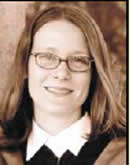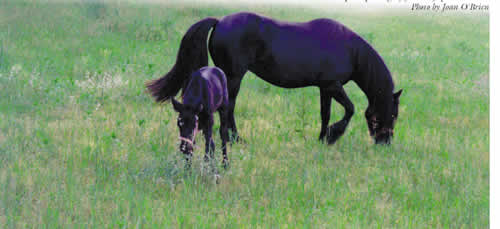|
|

 By Clare Illingworth,
By Clare Illingworth,
SPARK writer,
University of Guelph |
Fixed…in
one Fell swoop
A fresh approach to repairing a cleft palate lets a
rare pony foal live |
Less than a dozen
Fell ponies—a rare breed imported from northern England in the 1940s—exist
in Canada. So when one is born with a serious physical defect, alarm bells
sound. Fortunately, in the case of two-day-old Fell filly June Bug, Ontario
Veterinary College researchers were standing by. And, based on their experiences
with her, they now have a new way to help other horses with similar problems.
June Bug came to OVC two summers ago suffering from a cleft palate, a
tear to the soft palate located between the windpipe and throat. This
soft palate, along with another structure in the throat called the epiglottis,
come together to seal the air pipes when food is swallowed. The tear breaks
this seal, allowing milk to enter the windpipe and then the lungs. This
causes fatal pneumonia, essentially drowning the animal if left untreated.
It’s
a highly unusual problem in horses, but is not thought to be inherited.
Owner Joan O’Brien of Sterling, Ontario, knew she had trouble on
her hands. “June Bug was so small that our vet had to use dog-sized
instruments to inspect her mouth,” says O’Brien.
Because of the severity of the problem, June Bug was referred to OVC,
where
Dr. Ludovic Bouré took on her case.
Bouré took a new approach using human surgical instruments to repair
the tear. The traditional surgical procedure involved breaking the jaw
open and exposing the inner throat, which often results in infection of
the jaw bones. “It was much too invasive,” he says. “Besides,
the low chance of recovery means it’s hardly ever performed.”
For the surgery, Bouré used an endoscope—a small telescoped
video camera—and guided it through the anesthetized filly’s
mouth, allowing him to view the magnified site on a screen. Long instruments
such as needle drivers and scissors used for human laparoscopic surgery
were also entered through the mouth, to stitch the tear in the soft
palate. This allowed for a tight seal with the epiglottis.
June Bug spent two weeks at the hospital being treated for pneumonia.
She was fed by a stomach tube to prevent movement of the soft palate during
swallowing, which gave the stitches a chance to heal. Her progress was
reassessed after two weeks and results
showed that only a small portion of the palate had re-torn, but not enough
to
warrant another surgery.
The mare enjoyed a healthy recuperation and has grown into a fine pony.
She is beginning light training in riding and driving, and owing to her
impressive bloodlines she will join
O’Brien’s breeding program (she owns four of the eight Fell
ponies in Canada)
and have a foal of her own in 2003. O’Brien hopes that June Bug will
be central to her goal of improving the breed’s numbers and stock
quality in Canada.
PHOTO BELOW: Fell pony foal June Bug recovers at Deerstones Farm, with
mom
May Flower, after undergoing the first laproscopic surgery for a cleft
palate.
Photo by Joan O'Brien

www.erc.on.ca
|

